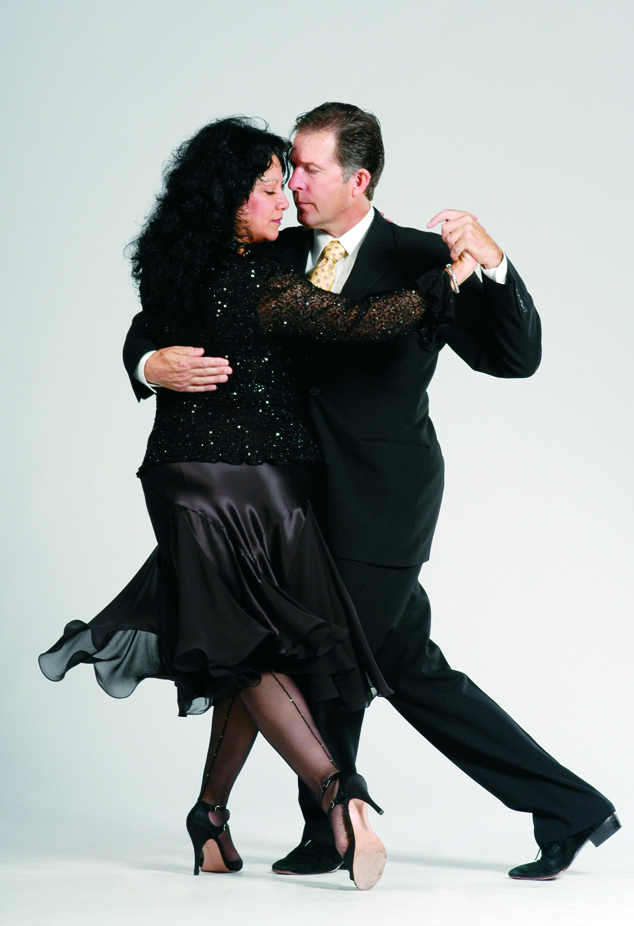
On that day in 1994 I didn't know how to walk.
"What do you mean?" I asked.
Nora Olivera stepped toward one of the chairs at the edge of the practice room, before a large mirror. She sat down and crossed her legs. I felt vulnerable before her, a laughable figure wet with sweat.
I could not see how I would ever achieve the sensuality in this tango dance that I had seen others achieve. That was completely out of the question, so remote a possibility that it seemed to have disappeared even before it had appeared, especially in view of the fact that I did not know how to walk.

Nora Olivera and Edward Neale: Photo: Nora's Tango Week. Used with permission.
"Poeta," Nora said. She looked at me with a smile of great regard, as though I might actually have a bit of talent. "You walk like the English."
I turned away, gesturing into the air.
"Wait!" she said. "Don't get me wrong. I have respect for the English." She placed an index finger below her right eye and looked up at me with comic sincerity. This conversation was taking place 12 years or so after the Malvinas (or Falklands) War between Argentina and Great Britain. "They nice people."
She stood and stepped out to the middle of the practice room. She positioned herself with her feet apart, her shoulders slightly hunched, her head hanging a bit forward. Her black hair surrounded her head and hung down from it like ringlets of obsidian.
"And this is how they walk," she said.
Nora took several steps, her feet a few inches apart from each other as she moved. There was little fluidity in her walk. She plodded like the Tin Woodsman stiff with rust.
"You see? The Industrial Revolution, yes?"
"Nora . . ." I whispered, amused by her characterization of my gait.
"But now, when you walk like this..."
She suddenly grew liquid, and she sauntered forward, her knees and ankles lightly brushing each other. There was something about her feet, the way that, as one passed the other in mid step, they appeared like two doves caressing each other in flight. Her shoulders moved as sensuously, her arms held up slightly, but sinuously, so that her erect head, that looked aside just now with a smile on the lips... so that she appeared to be heading for an unusually pleasureful union of some kind -- just where, no one knew - some sensual bower, some assignation.
"You see?" Nora asked, coming to a halt.
"Yes. But what do I see?" I asked.
Nora's eyes opened wide. "¡Che, Buenos Aires!" she said, gesturing at the ceiling. She turned back toward the mirror, adjusted her hair, and then smiled at herself. "And Buenos Aires, poeta, is tango."
Viewed from outside, tango does not necessarily seem so all-involving. It is a slow, complicated walk by two people in each others' arms. We are simply dancing, and often -- except for those true masters like Nora and her husband Edward Neale -- without distinction, to incredibly sad music. But when you are engaged with the person dancing with you, when you can feel her in your arms and can feel the feline contracting and stretching of her muscles, the intensity of her in your embrace, so private an embrace...
So that day in 1994, Nora began teaching me how to walk.
"You have a hallway?"
I was living in a long Victorian apartment in San Francisco, on the second floor. There was a hallway that ran the entire length of the apartment, the living room at one end, the kitchen at the other. Two bedrooms, a bathroom and a laundry room were connected to the hallway at various intervals. A Turkish rug runner ran the length of it. It could be rolled up, so that the hardwood beneath could be revealed.
I described the hallway for Nora.
"Good." She surveyed me. "You have a belt?"
"Yes."
"Good. You take that belt from your pants and put it around your knees."
"Now?"
"No! In the hallway!" Nora grinned. "You take the belt and you tighten it around your knees, so that they are always together." She began walking. "Then, put on the music. Something slow. Slow Pugliese. Slow Di Sarli."
Her steps were exaggerated but nonetheless very stylish. Her knees remained tightly together, and she proceeded in a straight line across the floor.
"This way, you'll learn how to walk," she said. "You can learn it in many other ways. And the ability you have...I'll teach you. But this way you learn it quick."
I was peeved. Maybe defeated.
"You want to get around in Buenos Aires, poeta," she said, "this is the way you do it."
So, that evening I put the belt around my knees. I hopped over to the stereo and put on the tango "Gallo Ciego". Hopping back to the beginning of the hallway, I started walking and fell down.
The music swirled. I gathered myself up to my hands and knees. I helped myself to my feet by grabbing the knob of the door that led to the kitchen. The bandoneón in the recording sounded like a lascivious church organ. I began walking again, and fell again.
The music continued. I felt Nora's voice. I felt her kindness. Che, I felt Buenos Aires! If I could find that walk, I could maybe find tango.
I took the doorknob again, pulled myself to my feet, and began walking. Slowly at first. Very clumsily. I stumbled once or twice more. But my knees were together. Then, surprisingly, almost as if naturally, my ankles brushed each other as I ascended the length of the hallway, two very clumsy doves.
I have studied twice a week with Nora since that day in 1994, and I can assure you that I now know how to walk.
